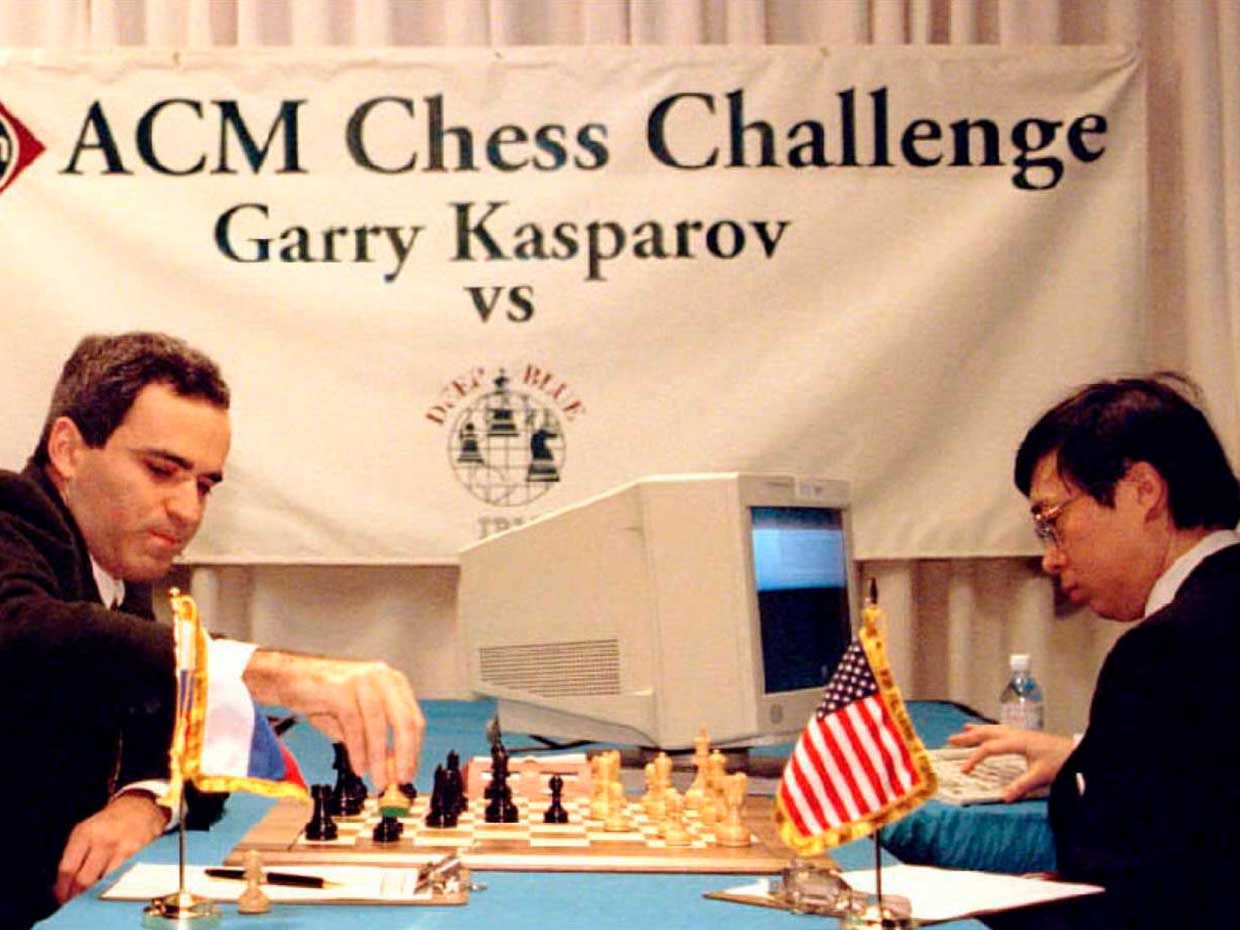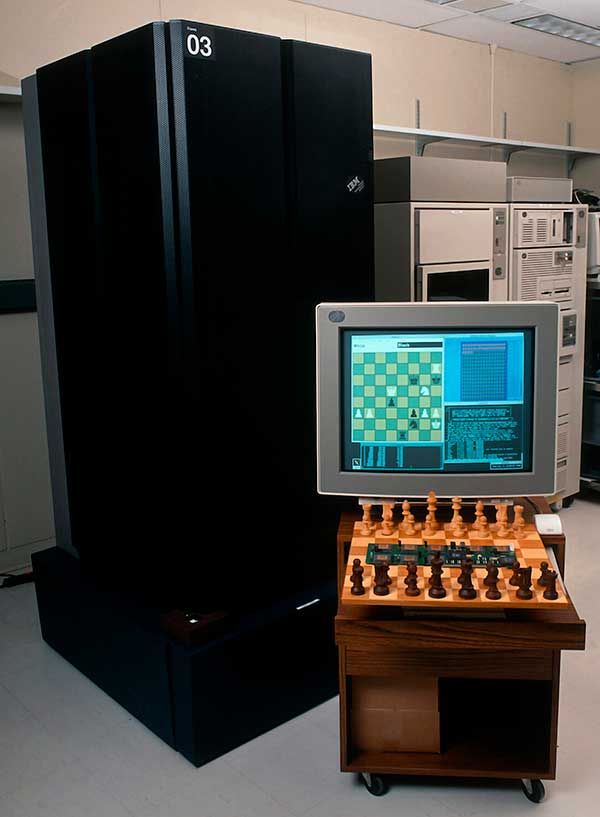How IBM’s Deep Blue Beat World Champion Chess Player Garry Kasparov
 Photo: Tom Mihalek/AFP/Getty Images World chess champion Garry Kasparov [left] playing against IBM's supercomputer Deep Blue in 1996 during the ACM Chess Challenge in Philadelphia.
Photo: Tom Mihalek/AFP/Getty Images World chess champion Garry Kasparov [left] playing against IBM's supercomputer Deep Blue in 1996 during the ACM Chess Challenge in Philadelphia. THE INSTITUTE Chess is making a comeback thanks to The Queen's Gambit, a popular Netflix miniseries about a prodigy's journey to becoming the world's greatest player. But Beth Harmon-the fictional prodigy portrayed by Anya Taylor-Joy-never faces a supercomputer the way real-life world champion Garry Kasparov did.
IBM's Deep Blue made history in 1997 when it became the first machine to beat a reigning world chess champion. A research team led by IEEE Senior Member Murray Campbell and Feng-hsiung Hsu developed the machine.
Kasparov accused the IBM team of cheating its way to victory. In reality, though, scientists had been interested in programming a computer to play chess since the late 1940s, according to an article on IBM's blog about Deep Blue. It took years for engineers and computer scientists to perfect the artificial intelligence program that would one day beat a world champion.
Five decades in the makingDeep Blue's story began in 1985, when Hsu, then a Carnegie Mellon graduate student, started working on his dissertation project: ChipTest, a chess-playing machine. Hsu worked with Campbell, who was a research associate at the university, and graduate student Thomas Anatharaman, an IEEE member, to develop ChipTest. Hsu and Campbell later joined IBM Research in Yorktown Heights, N.Y., in 1989. The duo continued developing a chess-playing machine but this time with other computer scientists working on the Deep Blue project.
 Photo: Yvonne Hemsey/Getty Images Deep Blue in IBM's headquarters in Armonk, N.Y.
Photo: Yvonne Hemsey/Getty Images Deep Blue in IBM's headquarters in Armonk, N.Y. The final version of the machine consisted of two 2-meter-tall towers, more than 500 processors, and 216 accelerator chips designed for computer chess, according to a paper Campbell and Hsu wrote about Deep Blue for the Artificial Intelligence journal.
The machine's software would calculate the basic moves it could make in response to its opponent before the accelerator chips carried out more complex calculations such as assessing possible outcomes of various moves and determining the best one. The computer would decide which route to take based on the information gathered by the chips. Deep Blue could explore up to 100 million possible chess positions per second, according to the IBM article.
Hundreds of millions of people around the world play chess," Campbell said in a 2017 Scientific American interview. It's known as a game that requires strategy, foresight, logic-all sorts of qualities that make up human intelligence. So it makes sense to use chess as a measuring stick for the development of artificial intelligence."
The team knew chess was the right game for Deep Blue to play, but the researchers had little experience with chess themselves. The team brought in grandmasters such as Joel Benjamin, who, at 13, had become the youngest-ever U.S. chess master.
The grandmasters helped the team in two ways: assisting in putting together a library of moves for the machine to access during games and playing against the machine so the team could pinpoint its weaknesses.
Humans have been studying chess openings for centuries and developed their own favorite moves," Campbell told Scientific American. The grandmasters helped us choose a bunch of those to program into Deep Blue.
Chess is an enormously complex game, and that's why it took us, as a field, 50 years of development to finally beat the world champion."
KASPAROV VS. DEEP BLUEAfter the machine lost its first match in 1996 against Kasparov, the research team went back to the drawing board.
According to Campbell, the team doubled the system's speed by developing a new chess chip-one with the enhanced ability to evaluate positions the pawns can take. The new version of Deep Blue was able to search up to 200 million options per second, depending on the pawns' position on the board. The researchers also increased the machine's knowledge of the game by enabling the chess chip to recognize and evaluate chess concepts including positions and lines of attack. The chips could then search through the possibilities and figure out the best move.
Part of the improvement is we detected more patterns in a chess position and could put values on them and therefore evaluate chess positions more accurately," Campbell said in the interview.
Deep Blue and Kasparov squared off again in 1997 in a six-game match. The grandmaster won the first game; the machine won the next one. The following three ended in a draw, and Deep Blue won the final game and thus the match.
Campbell said he and his team were confident that the 1997 Deep Blue was much better than the 1996 version," but they still hadn't expected it to win.
According to IBM, the development of Deep Blue inspired researchers to create supercomputers that could tackle other complex problems such as evaluating marketplace trends and risk analysis in finance; mining data; and analyzing molecular dynamics-which helped medical researchers develop new drugs.
Deep Blue is on display at the Smithsonian Institution, in Washington, D.C., although the museum is currently closed due to the COVID-19 pandemic.
IEEE membership offers a wide range of benefits and opportunities for those who share a common interest in technology. If you are not already a member, consider joining IEEE and becoming part of a worldwide network of more than 400,000 students and professionals.